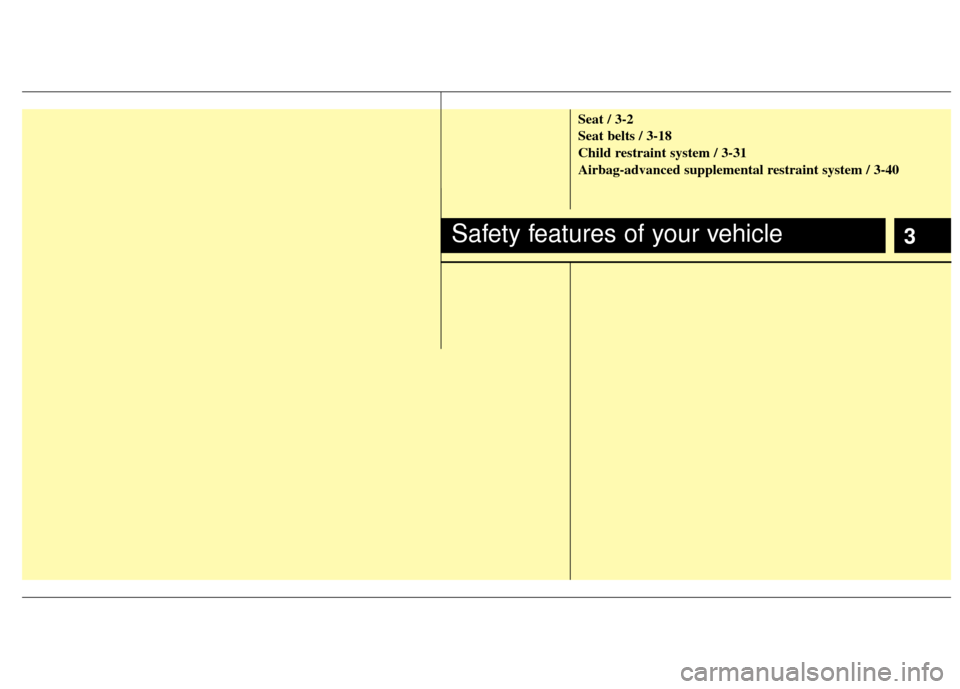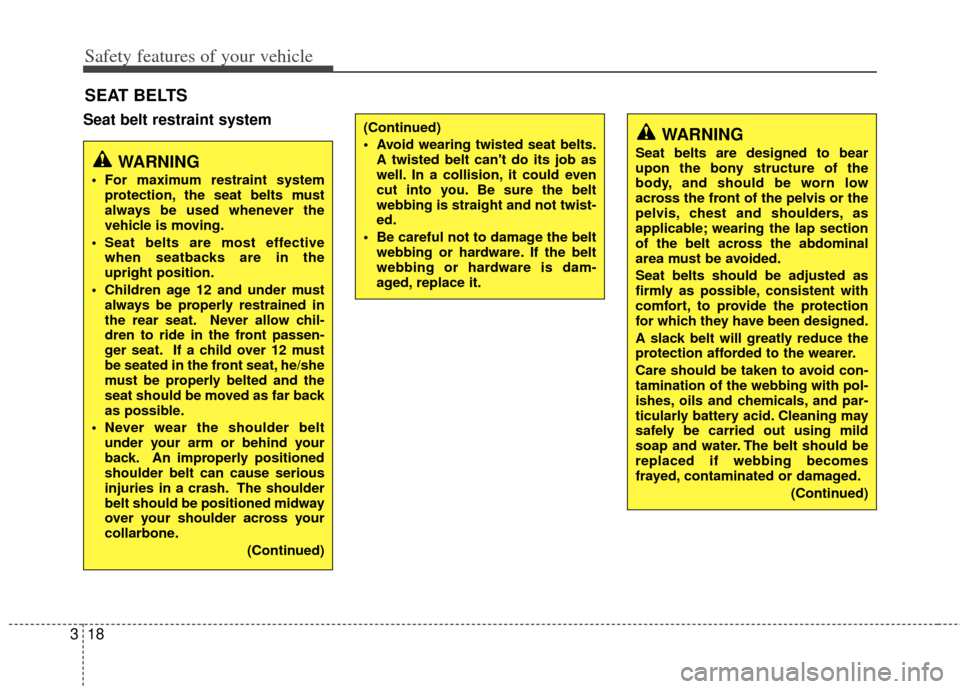2013 KIA Optima child seat
[x] Cancel search: child seatPage 6 of 382

I3
Index
Capacities (Lubricants) ··················\
··················\
················8-4
CareExterior care ··················\
··················\
··················\
··········7-56
Interior care ··················\
··················\
··················\
···········7-61
Tire care ··················\
··················\
··················\
·················7-31\
Cargo weight ··················\
··················\
··················\
············5-55
Center console storage ··················\
··················\
·············4-113
Central door lock switch··················\
··················\
············4-15
Certification label ··················\
··················\
··················\
······8-6
Changing tires ··················\
··················\
··················\
············6-8
Checking tire inflation pressure··················\
··················\
·7-33
Child restraint system ··················\
··················\
················3-31 Passenger seat belt ··················\
··················\
··················\
·3-34
Tether anchor system ··················\
··················\
···············3-36
Lower anchor system··················\
··················\
···············3-37
Child-protector rear door lock ··················\
··················\
···4-17
Climate control air filter ··················\
··················\
·4-100, 7-24
Clock (Digital) ··················\
··················\
··················\
·······4-118
Clothes hanger ··················\
··················\
··················\
·······4-119
Combined instrument, see instrument cluster ···············4-48
Compact spare tire ··················\
··················\
··················\
···6-13
Compact spare tire replacement ··················\
··················\
7-36
Compass mirror, see the Electric chromic mirror (ECM) with homeLink system and compass··················\
·········4-39
Cool box··················\
··················\
··················\
·················4-11\
4 Coolant ··················\
··················\
··················\
··················\
···7-17
Cooling fluid, see engine coolant ··················\
················7-17
Crankcase emission control system ··················\
·············7-62
Cruise control system ··················\
··················\
················5-37
Cup holder ··················\
··················\
··················\
·············4-116
Curtain air bag ··················\
··················\
··················\
·········3-58
Dashboard illumination, see instrument panel
illumination··················\
··················\
··················\
············4-49
Dashboard, see instrument cluster ··················\
···············4-48
Defogging (Windshield) ··················\
··················\
··········4-109
Defogging logic (Windshield) ··················\
··················\
·4-111
Defroster (Rear window) ··················\
··················\
···········4-91
Defrosting (Windshield) ··················\
··················\
··········4-109
Digital clock··················\
··················\
··················\
···········4-118
Dimensions ··················\
··················\
··················\
················8-2
Display illumination, see instrument panel illumination··················\
··················\
··················\
············4-49
Displays, see instrument cluster ··················\
··················\
4-48
Distance to service ··················\
··················\
··················\
···4-55
Door locks··················\
··················\
··················\
················4-13 Central door lock switch ··················\
··················\
·········4-15
Child-protector rear door lock ··················\
··················\
·4-17
Drinks holders, see cup holders··················\
·················4-11\
6
Driver's 3-point system with evergency locking retractor··················\
··················\
··················\
··················\
3-21
C
D
Page 22 of 382

3
Seat / 3-2
Seat belts / 3-18
Child restraint system / 3-31
Airbag-advanced supplemental restraint system / 3-40
Safety features of your vehicle
Page 27 of 382

Safety features of your vehicle
63
Automatic adjustment
(if equipped)
The front seat can be adjusted by using
the control knob located on the outside of
the seat cushion. Before driving, adjust
the seat to the proper position so as to
easily control the steering wheel, pedals
and switches on the instrument panel.
Forward and backward
Push the control switch forward or back-
ward to move the seat to the desired
position. Release the switch once the
seat reaches the desired position.
CAUTION
The power seat is driven by anelectric motor. Stop operatingonce the adjustment is complet-ed. Excessive operation maydamage the electrical equipment.
When in operation, the power seat consumes a large amount ofelectrical power. To preventunnecessary charging systemdrain, don’t adjust the power seatlonger than necessary while theengine is not running.
Do not operate two or more power seat control knobs at the sametime. Doing so may result inpower seat motor or electricalcomponent malfunction.
OTF030006
WARNING
The power seat is operable with the
ignition OFF.
Therefore, children should never be
left unattended in the car.
Page 31 of 382

Safety features of your vehicle
10
3
Each time you push the button, the
temperature setting of the seat is
changed as follows :
The seat warmer defaults to the OFF position whenever the ignition switch is
turned on.
✽ ✽ NOTICE
With the seat warmer switch in the ON
position, the heating system in the seat
turns off or on automatically depending
on the seat temperature.
CAUTION
When cleaning the seats, do not
use an organic solvent such aspaint thinner, benzene, alcoholand gasoline. Doing so may dam-age the surface of the heater or seats.
To prevent overheating the seat warmer, do not place anything onthe seats that insulates againstheat, such as blankets, cushionsor seat covers while the seatwarmer is in operation.
Do not place heavy or sharp objects on seats equipped withseat warmers. Damage to the seatwarming components could occur.WARNING- Seat warmer burns
Passengers should use extreme
caution when using seat warmers
due to the possibility of excess
heating or burns. The occupants
must be able to feel if the seat is
becoming too warm and to turn the
seat warmer off. The seat warmer
may cause burns even at low tem-
peratures, especially if used for
long periods of time. In particular,
the driver must exercise extreme
care for the following types of pas-
sengers:
1. Infants, children, elderly or dis-
abled persons, or hospital outpa-
tients
2. Persons with sensitive skin or those that burn easily
3. Fatigued individuals
4. Intoxicated individuals
5. Individuals taking medication that can cause drowsiness or
sleepiness (sleeping pills, cold
tablets, etc.)OFF → HIGH ( ) → LOW ( )
→
Page 33 of 382

Safety features of your vehicle
12
3
Active headrest
The active headrest is designed to move
forward and upward during a rear impact.
This helps to prevent the driver's and
front passenger’s head from moving
backward and thus helps prevent neck
injuries.Seatback pocket (if equipped)
The seatback pocket is provided on the
back of the front passenger’s seatback.
HNF2041-1OTF030016
WARNING- Seatback
pocket
Do not put heavy or sharp objects
in the seatback pocket. In an acci-
dent they could come loose from
the pocket and injure vehicle occu-
pants.
WARNING
A gap between the seat and the
headrest release button may
appear when seating on the seat or
when you push or pull the seat. Be
careful not to get your finger, etc.
caught in the gap.
WARNING
Passengers should use extreme
caution when using the climate
control seat to warm due to the
possibility of excess heating or
burns. The occupants must be able
to feel if the seat is becoming too
warm and to turn the seat warmer
off. In particular, the driver must
exercise extreme care for the fol-
lowing types of passengers:
1. Infants, children, elderly or dis-
abled persons, or hospital outpa-
tients
2. Persons with sensitive skin or those that burn easily
3. Fatigued individuals
4. Intoxicated individuals
5. Individuals taking medication that can cause drowsiness or
sleepiness (sleeping pills, cold
tablets, etc.)
Page 38 of 382

317
Safety features of your vehicle
Armrest
To use the armrest, pull it forward from
the seatback.
OTF030023N
CAUTION
When cleaning the seats, do notuse an organic solvent such asthinner, benzene, alcohol andgasoline. Doing so may damagethe surface of the heater or seats.
To prevent overheating the seat warmer, do not place anything onthe seats that insulates againstheat, such as blankets, cushionsor seat covers while the seatwarmer is in operation.
Do not place heavy or sharp objects on seats equipped withseat warmers. Damage to the seatwarming components could occur.WARNING- Seat warmer burns
Passengers should use extreme
caution when using seat warmers
due to the possibility of excess
heating or burns. The occupants
must be able to feel if the seat is
becoming too warm and to turn the
seat warmer off. The seat warmer
may cause burns even at low tem-
peratures, especially if used for
long periods of time. In particular,
the driver must exercise extreme
care for the following types of pas-
sengers:
1. Infants, children, elderly or dis-
abled persons, or hospital outpa-
tients
2. Persons with sensitive skin or those that burn easily
3. Fatigued individuals
4. Intoxicated individuals
5. Individuals taking medication that can cause drowsiness or
sleepiness (sleeping pills, cold
tablets, etc.)
Page 39 of 382

Safety features of your vehicle
18
3
Seat belt restraint system
SEAT BELTS
WARNING
For maximum restraint system
protection, the seat belts must
always be used whenever the
vehicle is moving.
Seat belts are most effective when seatbacks are in the
upright position.
Children age 12 and under must always be properly restrained in
the rear seat. Never allow chil-
dren to ride in the front passen-
ger seat. If a child over 12 must
be seated in the front seat, he/she
must be properly belted and the
seat should be moved as far back
as possible.
Never wear the shoulder belt under your arm or behind your
back. An improperly positioned
shoulder belt can cause serious
injuries in a crash. The shoulder
belt should be positioned midway
over your shoulder across your
collarbone.
(Continued)
(Continued)
Avoid wearing twisted seat belts.A twisted belt can't do its job as
well. In a collision, it could even
cut into you. Be sure the belt
webbing is straight and not twist-
ed.
Be careful not to damage the belt webbing or hardware. If the belt
webbing or hardware is dam-
aged, replace it.WARNING
Seat belts are designed to bear
upon the bony structure of the
body, and should be worn low
across the front of the pelvis or the
pelvis, chest and shoulders, as
applicable; wearing the lap section
of the belt across the abdominal
area must be avoided.
Seat belts should be adjusted as
firmly as possible, consistent with
comfort, to provide the protection
for which they have been designed.
A slack belt will greatly reduce the
protection afforded to the wearer.
Care should be taken to avoid con-
tamination of the webbing with pol-
ishes, oils and chemicals, and par-
ticularly battery acid. Cleaning may
safely be carried out using mild
soap and water. The belt should be
replaced if webbing becomes
frayed, contaminated or damaged.
(Continued)
Page 40 of 382

319
Safety features of your vehicle
Seat belt warning (for driver’s seat)
The driver's seat belt warning light and
chime will activate to the following table
when the ignition switch is in "ON" posi-
tion.
(Continued)
It is essential to replace the entire
assembly after it has been worn in
a severe impact even if damage to
the assembly is not obvious. Belts
should not be worn with straps
twisted. Each belt assembly must
only be used by one occupant; it is
dangerous to put a belt around a
child being carried on the occu-
pant's lap.
1GQA2083
WARNING
No modifications or additionsshould be made by the user
which will either prevent the seat
belt adjusting devices from oper-
ating to remove slack, or prevent
the seat belt assembly from being
adjusted to remove slack.
When you fasten the seat belt, be careful not to latch the seat belt in
buckles of other seat. It's very dan-
gerous and you may not be pro-
tected by the seat belt properly.
Do not unfasten the seat belt and do not fasten and unfasten the
seat belt repeatedly while driving.
This could result in loss of con-
trol, and an accident causing
death, serious injury, or property
damage.
When fastening the seat belt, make sure that the seat belt does
not pass over objects that are
hard or can break easily.
Make sure there is nothing in the buckle. The seat belt may not be
fastened securely.